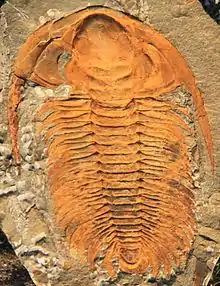Artiopoda
The Artiopoda is a grouping of extinct arthropods that includes trilobites and their close relatives. It was erected by Hou and Bergström in 1997[1] to encompass a wide diversity of arthropods that would traditionally have been assigned to the Trilobitomorpha. Hou and Bergström used the name Lamellipedia as a superclass to replace Trilobitomorpha that was originally erected at the subphylum level, which they considered inappropriate.
| Artiopoda | |
|---|---|
 | |
| Paradoxides a trilobite | |
 | |
| Phytophilaspis, a Xandarellid | |
| Scientific classification | |
| Kingdom: | Animalia |
| Phylum: | Arthropoda |
| (unranked): | †Artiopoda Hou and Bergstrom, 1997 |
| Subgroupings | |
| |
Description
Most Artiopods are broadly similar in morphology to trilobites, possessing a dorsoventrally compressed body, with a trunk composed of between 6 and 19—generally 10 to 12—articulated segments, most of which contain wide pleurae. These pleurae are absent in the posteriormost segment, which bears a pair of non-walking appendages, and may be absent in the two or three posteriormost segments in rare cases. The appendage-bearing segment is fused to the telson in certain members of Artiopoda, including some aglaspidids, which may have secondarily lost the appendages.[2]
Trilobites and their relatives
Leif Størmer recognised on the basis of limb types that a diverse group of Cambrian arthropods, known largely from the Burgess Shale, were likely to be relatives of the trilobites. Hou and Bergström formalised this grouping into the Lamellipedia, consisting of two clades: the Marrellomorpha and the Artiopoda. The Artiopoda have subsequently been considered to consist of two clades; one reusing Trilobitomorpha to encompass trilobites, nektaspids, concilitergans and xandarellids, and the other called Vicissicaudata encompassing aglaspidids, xenopods and cheloniellids.[3] This topology is not recovered in some studies.[4]
The broader relationships of the artiopods (and lamellipedians) currently remain unclear, and the possibility that they are a paraphyletic assemblage giving rise to the crown-group euarthropods cannot be excluded. However, they may also be a clade in the stem-group of the Mandibulata or Euarthropoda as a whole.
References
- Hou, X. & Bergström, J. 1997. Arthropods of the Lower Cambrian Chengjiang fauna, southwest China. Fossils and Strata, No. 45. Scandinavian University Press, Oslo, 22 Dec 1997: 116 pp.
- Lerosey-Aubril, Rudy; Zhu, Xuejian; Ortega-Hernández, Javier (September 11, 2017). "The Vicissicaudata revisited – insights from a new aglaspidid arthropod with caudal appendages from the Furongian of China". Scientific Reports. 7 (1): 11117. doi:10.1038/s41598-017-11610-5. PMC 5593897. PMID 28894246.
- Ortega-Hernández, Javier; Legg, David A.; Braddy, Simon J. (February 2013). "The phylogeny of aglaspidid arthropods and the internal relationships within Artiopoda". Cladistics. 29 (1): 15–45. doi:10.1111/j.1096-0031.2012.00413.x.
- Hou, Xianguang; Williams, Mark; Gabbott, Sarah; Siveter, David J.; Siveter, Derek J.; Cong, Peiyun; Ma, Xiaoya; Sansom, Robert (2017-09-02). "A new species of the artiopodan arthropod Acanthomeridion from the lower Cambrian Chengjiang Lagerstätte, China, and the phylogenetic significance of the genus". Journal of Systematic Palaeontology. 15 (9): 733–740. doi:10.1080/14772019.2016.1229695. hdl:2381/41202. ISSN 1477-2019. S2CID 3430086.